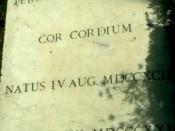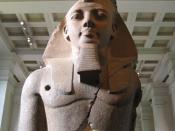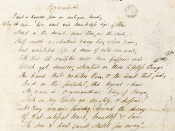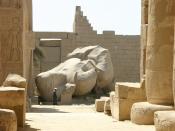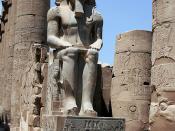Shelley abhors the ruling class, and seems to think that significant sociopolitical change is on the horizon. In ÃÂOzymandiasÃÂ, Shelley explains his cynicism with the power of the ruling class and doubts its great impact on humanity as a whole. Shelley uses king Ozymandias of Egypt to illustrate how ÃÂmightyÃÂ rulers are worthless to humanity. Their power, like that of Ozymandias, will not withstand the test of time. Ironically, even though the king was very powerful, now, everything he stood for has been destroyed. He thought he was an important and mighty man, but his kingdom has decayed and is a ÃÂcolossal Wreck, boundless and bareÃÂ (11-12).The central theme of "Ozymandias" is the inevitable decline of all leaders, and of the empires they build, however mighty in their own time.
The 'Younger Memnon' statue of Ramesses II in the British Museum thought to have inspired the poemOzymandias was another name for Ramesses the Great, Pharaoh of the nineteenth dynasty of ancient Egypt.[4]
Ozymandias represents a transliteration into Greek of a part of Ramesses' throne name, User-maat-re Setep-en-re. The sonnet paraphrases the inscription on the base of the statue, given by Diodorus Siculus as "King of Kings am I, Osymandias. If anyone would know how great I am and where I lie, let him surpass one of my works."[5] Shelley's poem is often said to have been inspired by the arrival in London of a colossal statue of Ramesses II, acquired for the British Museum by the Italian adventurer Giovanni Belzoni in 1816.[6] Rodenbeck and Chaney, however,[7] point out that the poem was written and published before the statue arrived in Britain, and thus that Shelley could not have seen it. Its repute in Western Europe preceded its actual arrival in Britain (Napoleon had previously made an unsuccessful attempt to acquire it for France, for example), and thus it may have been its repute or news of its imminent arrival rather than seeing the statue itself which provided the inspiration.
The 2008 edition of the travel guide Lonely Planet's guide to Egypt says that the poem was inspired by the fallen statue of Ramesses II at the Ramesseum, a memorial temple built by Ramesses at Thebes, near Luxor in Upper Egypt.[8] This statue, however, does not have "two vast and trunkless legs of stone", nor does it have a "shattered visage" with a "frown / And wrinkled lip, and sneer of cold command." (In fact, all statues of Egyptian kings have a uniform expression of serene benevolence.) Nor does the base of the statue at Thebes have any inscription, although Ramesses's cartouche is inscribed on the statue itself.
Among the earlier senses of the verb "to mock" is "to fashion an imitation of reality" (as in "a mock-up"),[9] but by Shelley's day the current sense "to ridicule" (especially by mimicking) had come to the fore.
The sonnet celebrates the anonymous sculptor and his artistic achievement, whilst Shelley imaginatively surveys the ruins of a bygone power to fashion a sinuous, compact sonnet spun from a traveller's tale of far distant desert ruins. The lone and level sands stretching to the horizon perhaps suggest a resultant barrenness from a misuse of power where "nothing beside remains".
[edit]Smith's poemIn Egypt's sandy silence, all alone,Stands a gigantic Leg, which far off throwsThe only shadow that the Desert knows:"I am great OZYMANDIAS," saith the stone,"The King of Kings; this mighty City shows"The wonders of my hand." The City's gone,Nought but the Leg remaining to discloseThe site of this forgotten Babylon.
We wonder, and some Hunter may expressWonder like ours, when thro' the wildernessWhere London stood, holding the Wolf in chace,He meets some fragments huge, and stops to guessWhat powerful but unrecorded raceOnce dwelt in that annihilated place.
ÃÂHorace Smith.[10]Percy Shelley apparently wrote this sonnet in competition with his friend Horace Smith, as Smith published a sonnet a month after Shelley's in the same magazine. It takes the same subject, tells the same story, and makes the same moral point. It was originally published under the same title as Shelley's verse; but in later collections Smith retitled it "On A Stupendous Leg of Granite, Discovered Standing by Itself in the Deserts of Egypt, with the Inscription Inserted Below".[11][edit]LegacyJared Diamond's book Collapse has the poem "Ozymandias" in its foreword.
The Economist alluded to this poem while discussing the Burj Khalifa, with an article entitled "Look upon my works, Ye Mighty".
Dorothy Gambrell's webcomic Cat and Girl has spawned a "Trophy of Perpetual Futility" for sale at Topatoco. It is a small statue of a man with a cape and crown holding a scepter with the inscription "My Name is Ozymandias, King of Kings: Look on my works, ye Mighty, and Despair."Ozymandias (real name Adrian Veidt) is a character in the comic book limited series Watchmen.
It has also inspired the song "My Name is Ozymandias" by Gatsby's American Dream.
Ozymandias is a character who appears quoting the poem in The White Mountains, the first novel in John Christopher's post-apocalyptic trilogy The Tripods.
"Aussiemandias" is a song by the Australian band TISM, from their "Beasts of Suburban" album of 1992. It concerns race relations issues in Australia.
Bibliography;http://uk.answers.yahoo.com/question/index?qid=20090116103547AATBdaThttp://en.wikipedia.org/wiki/Ozymandias
